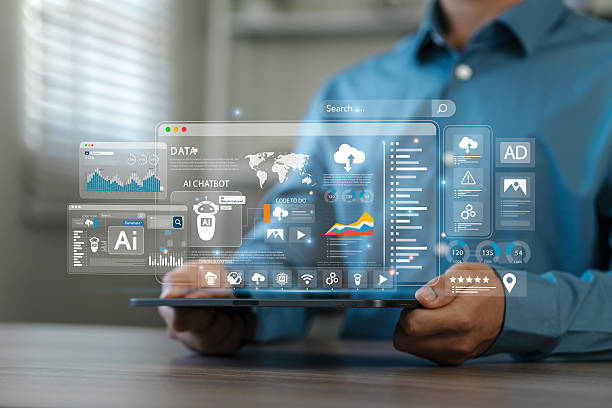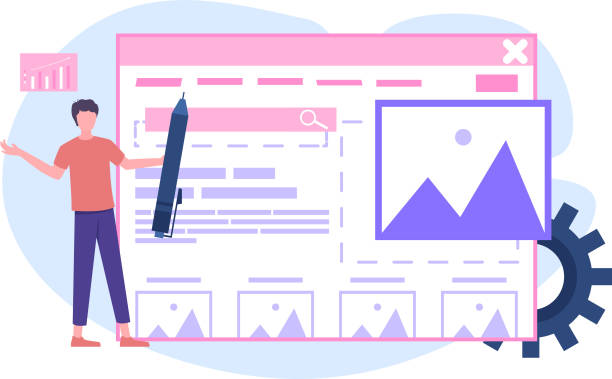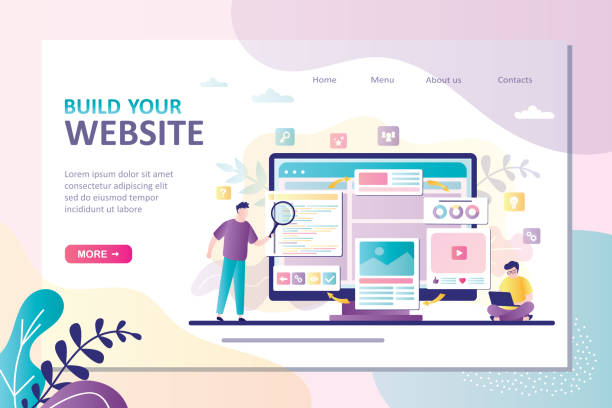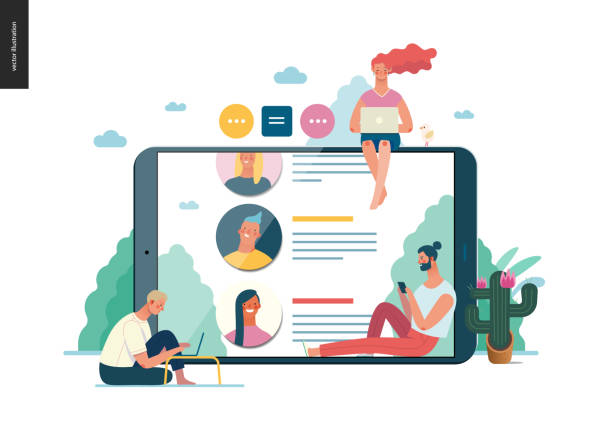Introduction to Modern User Interface Design and Its Importance in Today’s World

In the current digital age, where the internet has become an inseparable part of our daily lives, websites are no longer merely tools for displaying information; rather, they have transformed into key points for interaction, customer attraction, and service provision.
Amidst this, website design with a modern user interface (Modern UI Design for Websites) has gained more importance than ever.
A modern user interface not only makes your website visually appealing but also provides an efficient, intuitive, and enjoyable experience for visitors.
This approach goes beyond mere aesthetics, focusing on ease of use, efficiency, and creating a positive feeling for the user.
The ultimate goal is to convert visitors into loyal customers and promote meaningful interactions.
Research shows that 88% of users are unlikely to return to a website after a bad user experience; this is a startling statistic that clearly demonstrates the negative impact of a poor UI on a business’s credibility and profitability.
This explanatory and educational section will help you gain a deeper understanding of the nature and necessity of a modern user interface.
In fact, website design with a modern user interface is the cornerstone of any successful online presence that seeks to endure and grow in today’s competitive market.
By providing an unparalleled user experience, you not only attract more users but also increase their retention rate and create a sustainable competitive advantage for your business.
In the remainder of this article, we will delve into various aspects of this design and provide the necessary guidance for creating a powerful and user-friendly website.
Are you annoyed by losing customers due to your online store’s outdated appearance or slow speed? Rasaweb’s expert team solves these problems with professional e-commerce website design!
✅ Increase customer trust and your brand’s credibility
✅ Stunning speed and excellent user experience
Get a free consultation with Rasaweb now ⚡
Key Principles in User-Friendly and Efficient UI Design

To achieve website design with a modern user interface, one must adhere to a set of proven principles and strategies.
The first principle is simplicity and clarity.
Users should not be confused when looking for information or performing desired operations; every element on the page should have a clear purpose and be logically arranged.
Avoid visual clutter and provide only essential information to the user.
The second principle is visual and interactive feedback.
Users need to know the outcome of their actions; for example, a button should change color after being clicked, an icon should temporarily light up, or a success message should be displayed.
These feedbacks build user trust and give them a sense of control.
Consistency in design is also of high importance; similar elements should function in the same way across the website and follow consistent design patterns so that users have a unified learning experience.
This specialized and educational approach helps users quickly become familiar with your user interface.
Prioritizing information and using appropriate visual hierarchy (such as different font sizes, colors, and white space) helps to highlight more important content and direct user attention towards main goals.
Also, the possibility of error recovery and undoing operations is an important principle that allows users to interact with the website without fear of making mistakes.
Finally, attention to small details, subtle animations, and micro-interactions can make a big difference in user experience and make your website feel alive and engaging.
These principles are the foundation of any advanced UI design that aims to attract and retain users.
The Impact of Modern User Interface on Conversion Rates and Business Success

Website design with a modern user interface is not merely an aesthetic preference, but a strategic and vital investment that directly impacts your conversion rates and overall business success.
An efficient and appealing user interface can significantly increase the conversion rate of visitors into customers, subscribers, or active users.
Imagine a user visiting your website and quickly finding the information they need, easily adding products to their shopping cart, and completing the payment process without any issues.
This positive experience not only leads to direct sales but also strengthens customer loyalty and increases their likelihood of returning for future purchases or interactions.
On the other hand, a poor user interface can quickly frustrate users and cause them to leave your website in a matter of seconds (increasing the bounce rate).
This not only means losing potential sales but also seriously damages your brand and online reputation.
Analytical and specialized studies show that companies that seriously invest in user experience can achieve a significant return on investment (ROI), sometimes up to 100 times the initial investment cost.
For example, companies that focus on UI/UX can see an 83% increase in conversion rates and a 78% decrease in bounce rates.
The table below shows the key metrics for evaluating the success of a modern user interface and how it impacts business:
| Key Metric | Description | Direct Impact on Business Success |
|---|---|---|
| Conversion Rate | The percentage of users who complete a desired action (such as purchase, registration, download). | Direct increase in revenue and achievement of business goals. Good UI/UX simplifies the conversion process. |
| Bounce Rate | The percentage of users who view only one page and leave the website. | Lower bounce rate indicates initial website appeal and user-friendliness; fewer lost users. |
| Time on Site/Session Duration | Average time users spend on your website and the number of pages viewed. | Increased user engagement with content and services, increased likelihood of conversion and loyalty. |
| User Satisfaction | Overall satisfaction of users with their interaction with the website. | Measurable through surveys and feedback; a crucial factor in loyalty, word-of-mouth marketing, and brand reputation. |
| Page Load Speed | The time required for website pages to fully load. | High speed prevents user frustration, reduces bounce rate, and improves SEO. |
| User Errors | The number of times users make mistakes or get confused while performing a task. | Reduced errors indicate intuitive design and decreased need for customer support. |
Investing in website design with a modern user interface means investing in the future of your business and creating a sustainable competitive advantage that will yield tangible financial results.
This shows how powerful creating a website with a modern UI can be.
Advanced Tools and Technologies in UI/UX Design for Creating Modern Websites

To implement website design with a modern user interface, designers and developers need a set of advanced tools and technologies that facilitate every stage of the design and development process.
In the educational and initial design phase, tools such as Adobe XD, Figma, and Sketch serve as the backbone for designing prototypes, wireframes, and graphical user interfaces (GUI).
Figma has become highly popular due to its real-time, cloud-based collaboration capabilities, while Adobe XD and Sketch also offer powerful features for design and prototype animations.
These tools allow for rapid iteration of ideas, immediate feedback from stakeholders, and the creation of interactive prototypes, which are crucial for user testing.
In the development phase, front-end technologies like HTML5 (for structure), CSS3 (for styling and complex layouts), and JavaScript (for interactivity) are combined with powerful frameworks and libraries such as React.js, Vue.js, and Angular to create dynamic, responsive, and highly optimized user interfaces.
React, with its component-based approach, Vue, with its simplicity and flexibility, and Angular, with its comprehensive framework, each offer specific advantages for creating a website with a modern UI.
The use of Design Systems is also a specialized and essential approach that encompasses a set of reusable components, visual guidelines, and design principles.
These systems help maintain consistency and stability in the project, significantly reduce development time, and enable design scalability.
Finally, user testing tools like Hotjar (for heatmaps and session recordings) and Google Analytics (for analyzing traffic data and user behavior) are essential for collecting data and analyzing user behavior after launching the website, allowing for analytical improvements and continuously maintaining a modern web user experience.
Is your company’s website as professional and trustworthy as it should be? With specialized corporate website design by Rasaweb, create an online presence that reflects your credibility and attracts more customers.
✅ Building a powerful and professional image for your brand
✅ Converting visitors into real customers
⚡ Get a free consultation now!
The Importance of User Research and Persona Creation in Successful UI Design

One of the most important and fundamental steps in the process of website design with a modern user interface is a deep and comprehensive understanding of the target users.
This phase begins with User Research.
Without knowing who your users are, what their needs are, what goals they pursue, and what challenges and problems they face, you cannot design a truly useful, efficient, and aligned user interface that meets their expectations.
There are various methods for user research, including in-depth interviews (to understand qualitative motivations and needs), surveys (to collect quantitative data from larger groups), observing user behavior in natural or laboratory settings (Usability Testing), and analyzing existing website data (such as Google Analytics and Heatmaps).
This data provides valuable insights that form the basis of design decisions.
After collecting and analyzing information thoroughly, the next step is persona creation.
Personas are semi-fictional characters, based on real data, that represent the key characteristics of a group of real users.
Each persona includes details such as name, age, occupation, goals, motivations, pain points, and usage scenarios when interacting with the website.
Creating personas is a guidance and very powerful approach that helps the design team to always keep users in mind and make design decisions based on their real needs and concerns.
For example, if you are designing an e-commerce website, you might create personas for a “low-income student looking for discounts” or “working parents with limited time,” each having different needs and behaviors in online shopping.
This deep understanding enables advanced UI design specifically optimized to cater to different user groups, providing a personalized and effective experience.
This process forms the foundation of every successful website design with a modern user interface and ensures that the final product is truly user-centric.
Responsive Design and Mobile-First User Experience in Today’s Era

In an era where a significant portion of internet traffic occurs via mobile phones and tablets, the importance of website design with a modern user interface with a responsive and mobile-first approach becomes increasingly evident.
A responsive website is one whose design automatically adjusts to the screen size of the user’s device (whether desktop, laptop, tablet, or mobile) without compromising quality, providing an optimal experience on every device.
This means no need for zooming, annoying horizontal scrolling, or excessive movement to view content, all of which can quickly frustrate the user.
The “Mobile-First” approach, which is a specialized and educational guide in web design, states that the design and development process should start by considering the smallest screen size (mobile) and then gradually expand to larger and more complex screens.
This method ensures that even in the most limited screen space, the website’s core content and functionality are displayed correctly and flawlessly, without compromising the user experience.
This approach helps us focus on core priorities and prevent information overload on smaller devices.
Google has also preferred mobile-friendly websites in its search rankings for years, making the importance of responsiveness crucial not only for users but also for SEO.
Optimizing loading speed for mobile is also very important in this regard, as mobile users often have less patience for pages to load.
These approaches help you provide a modern web user experience across all platforms and attract a wider audience.
Adhering to Accessibility and Inclusivity Principles in Modern UI Design

One of the often-overlooked but vital aspects of website design with a modern user interface is adhering to Accessibility principles.
Accessibility means ensuring that your website is usable by everyone, including those with disabilities (such as visual, auditory, motor, or cognitive impairments).
Ignoring this group of users is not only ethically wrong, depriving them of access to information and services, but can also lead to losing a significant portion of the audience (approximately 15% of the world’s population has some form of disability) and even result in severe legal consequences and penalties in some countries.
International standards like WCAG (Web Content Accessibility Guidelines), published by the World Wide Web Consortium (W3C), provide a set of guidelines for creating accessible web content.
These principles include using alternative text (Alt Text) for images (read by screen readers for visually impaired individuals), ensuring proper color contrast between text and background (for low-vision individuals), enabling full keyboard navigation (for individuals with motor impairments), providing captions for videos and transcripts for audio content (for deaf individuals), and designing understandable forms with clear feedback.
A truly modern website UI design must be inclusive, providing a consistent user experience for everyone, regardless of their abilities.
This is not only a technical and legal requirement but also a humanitarian and responsible approach to web design that allows all members of society to use online services and information.
The table below outlines some key aspects of accessibility and how to implement them in design:
| Accessibility Principle | Description and Importance | How to Implement in Design and Development |
|---|---|---|
| Alternative Text (Alt Text) | Textual description for images and other non-text content. Crucial for content comprehension by screen readers. |
Provide a short, descriptive alt text for every meaningful image. Mark decorative content with alt=””. |
| Appropriate Color Contrast | Sufficient difference between text and background colors for better readability, especially for individuals with low vision and color blindness. | Use contrast checking tools (e.g., Contrast Checker) to ensure the contrast ratio is at least 4.5:1. |
| Keyboard Navigation | Ability to fully use all interactive website elements solely with a keyboard (without a mouse). | Ensure all buttons, links, and form fields are accessible via the Tab key and have a clear Focus State. |
| Captions and Transcripts | Provide alternative text for audio and visual content, such as captions for videos and full transcripts for podcasts. | For all multimedia content, provide caption and transcript options to make it accessible for deaf individuals. |
| Clear Error Messages | Provide clear feedback and guidance for correcting user input errors in forms. | Design error messages to be clear, understandable, and with specific guidance for troubleshooting. |
| Appropriate Structure and Hierarchy | Use semantic HTML tags and logically organize content with headings and lists. | Use Heading Tags (h1, h2, h3…) in logical order and appropriate HTML tags for lists, tables, and other elements. |
Focusing on these principles demonstrates your commitment to a comprehensive user experience and is a vital element in website design with a modern user interface.
This approach not only benefits individuals with disabilities but also improves the overall quality of the user experience for everyone.
New Trends in User Interface and User Experience Design in the Digital World

The world of website design with a modern user interface is constantly evolving, with new trends rapidly emerging.
Awareness of these trends is essential for maintaining the freshness, appeal, and efficiency of your website among competitors.
One important trend is the increased use of Microinteractions.
These are small details that respond to user interactions and give a sense of life and dynamism to the user interface, such as the subtle shake of an icon after a click, the display of a short animation during data loading, or the color change of a button after a successful action.
These micro-interactions make the user experience more enjoyable and intuitive.
Other trends include the use of 3D and realistic images and graphics, which can add unparalleled depth and visual appeal to a website and distinguish it from competitors.
Minimalism and smart use of whitespace continue to be popular, as they help users focus on the main content and prevent visual clutter and excessive cognitive load.
Dark Mode has also become a standard feature in many modern user interfaces due to reduced eye strain and battery saving on devices.
Voice User Interfaces (VUI) and advanced Artificial Intelligence (AI) integration are also growing trends that allow for interaction without a keyboard or mouse, offering an entirely new and more natural experience.
This news and entertaining section gives you insight into the future of this field.
Keeping pace with these advancements allows you to maintain a modern website UI design and stay ahead.
These trends indicate how advanced UI design is evolving towards more natural and intelligent interactions.
Are you tired of your company’s website not being seen as it should be, and losing potential customers? Solve this problem forever with professional and effective website design by Rasaweb!
✅ Increasing brand credibility and gaining customer trust
✅ Attracting targeted sales leads
⚡ Contact us now for a free consultation!
Challenges and Solutions for Successful Modern UI Implementation

Implementing website design with a modern user interface, despite its numerous benefits, is not without challenges and requires careful planning and a strategic approach.
One of the biggest challenges is the continuous changes in technology and design trends.
What is considered modern and advanced today might become obsolete in a few months.
This necessitates continuous learning, updating knowledge and skills, and high flexibility within the design and development team.
Another challenge is the balance between aesthetics and functionality.
Sometimes, a very beautiful design might not be user-friendly, severely reduce website loading speed, or be technically very difficult and costly to implement.
This is a challenging content that many designers and project managers face.
Furthermore, managing the expectations of project stakeholders and clients can also be challenging, especially when their ideas conflict with user experience principles or technical limitations.
The solutions to overcome these challenges include:
- Continuous testing and iteration: Through A/B tests, user tests with real users, and continuous feedback collection, identify strengths and weaknesses of the user interface and improve them iteratively.
This is an endless process. - Agile Development: Instead of one large and lengthy project, conduct design and development in small, manageable, and iterative stages.
This method allows for flexibility, rapid adaptation to changes, and early product delivery to the market. - Standardization with Design Systems: Using design systems and reusable components to maintain consistency, visual and functional stability, and reduce development time in large projects.
- Investing in specialists: Collaborating with experienced designers and developers who have a deep understanding of UI/UX principles and can anticipate challenges and provide creative solutions.
- Focus on data: Making decisions based on analytical data of user behavior instead of guesswork helps you implement improvements in a targeted manner.
Overcoming these challenges requires an analytical, strategic, and flexible approach that allows you to successfully implement and maintain a modern website UI design and always stay ahead.
These challenges are constant and require a flexible mindset ready for learning and adaptation to continuously deliver a modern web user experience.
The Future of User Experience on the Web: From Virtual Reality to Artificial Intelligence

The future of website design with a modern user interface extends beyond the flat pages and button-based interactions we know today.
We are witnessing the emergence of technologies that will fundamentally transform how we interact with the web, enabling unprecedented experiences.
Virtual Reality (VR) and Augmented Reality (AR) hold unparalleled potential for creating immersive and three-dimensional experiences.
In these spaces, users can virtually navigate a web environment, interact with its elements in entirely new and more natural ways, and even virtually try out products in their real surroundings.
Imagine instead of clicking on product images in an online store, you could rotate it in a 3D environment and examine it from different angles, or even virtually place it in your living room to see how it looks!
Artificial intelligence (AI) and Machine Learning will also play an increasing role in personalizing and smartening the user experience.
From smart chatbots and voice assistants that provide 24/7 support and anticipate user needs, to algorithms that tailor website content, product recommendations, or even UI layout based on user interests, past behavior, and profile, AI can make user interfaces smarter, more predictive, and more personalized.
These trends paint an entertaining and exciting vision of a modern web user experience where websites not only respond to our inputs but also anticipate our needs and deliver a completely personalized experience.
Creating a website with a modern UI in the future will mean leveraging these advanced capabilities to create unprecedented and highly interactive experiences for users.
These developments not only signify the future of website design with a modern user interface but also propel us towards a smarter, more intuitive, and highly personalized web.
Frequently Asked Questions
| Question | Answer |
|---|---|
| What is a modern user interface? | A modern user interface refers to a design that utilizes new trends, simplicity, excellent user experience, and attractive visual elements. |
| Why is using a modern user interface important in website design? | It attracts and retains more users, creates a professional impression, improves user experience, and increases conversion rates. |
| What are the main features of a modern user interface? | Simplicity, ample use of white space, readable typography, attractive and harmonious colors, subtle animations, and responsive design. |
| How is responsiveness related to a modern user interface? | Responsive design is an essential feature in a modern user interface that ensures the website is displayed well on all devices (mobile, tablet, desktop). |
| What is the role of typography in modern user interface design? | Choosing appropriate fonts and using them correctly enhances readability and contributes to the website’s beauty and visual identity. |
| What is White Space and why is it important in modern UI? | It is the empty space between different elements on the page that helps improve readability, user focus, and creates a sense of cleanliness and order. |
| What is the benefit of using animations in modern user interface design? | Subtle and purposeful animations can attract user attention, improve interaction, and make information transfer more engaging. |
| How can User Experience (UX) be improved alongside a modern user interface? | By understanding user needs, simplifying navigation paths, providing appropriate visual feedback, and easy testability. |
| Does a modern user interface always mean using bright colors? | No, a modern user interface can use various color palettes, including dark colors; the important thing is choosing harmonious colors suitable for the brand. |
| What are the current trends in modern user interface design? | The use of Dark Mode, Neumorphism, Glassmorphism, scroll-based animations, and minimalist design. |
And other services of Rasa Web Advertising Agency in the field of advertising
Smart Website Development: Professional optimization to increase website traffic using user experience customization.
Smart Advertorial: Revolutionize sales growth with smart data analysis.
Smart Data Analysis: A specialized service for increasing website traffic growth based on marketing automation.
Smart Customer Journey Map: A specialized service for increasing website traffic growth based on marketing automation.
Smart Marketing Automation: An effective tool for improving SEO rankings with precise audience targeting.
And over a hundred other services in the field of online advertising, advertising consulting, and organizational solutions
Online Advertising | Advertising Strategy | Advertorial
Resources
Principles of Modern Web DesignThe Importance of User Interface and User Experience in WebsitesResponsive Design Guide for WebsitesThe Future of Web Design and New Trends
? Ready to transform your business in the digital world? Rasaweb Afarin Digital Marketing Agency, by offering comprehensive and innovative solutions, is with you on the path to success. For sustainable growth, from **modern UI website design** to SEO strategies and targeted advertising campaigns, contact us.
📍 Tehran, Mirdamad Street, next to Bank Markazi, Southern Kazeroon Alley, Ramin Alley, No. 6



